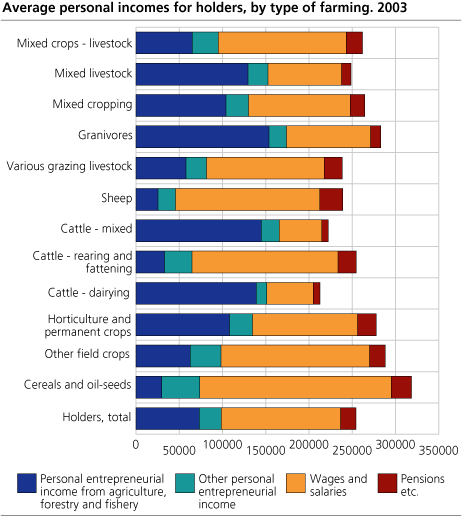Content
Published:
This is an archived release.
Many farmers without personal income from farming
47 per cent of the farmers operating individual holdings did not gain estimated personal income from the primary industries in 2003. Nevertheless, for 34 per cent of the farmers, personal income from the primary industries made up 50 per cent or more of the total personal income.
The statistics are based on the tax assessment for personal taxpayers and cover all holdings operated by a natural person. Out of a total of 58 200 holdings in 2003, 56 200 were operated by a natural person. The holdings vary much in size, from hobby like production to holdings with a turnover of more than NOK one million.
As from 1999 to 2003 the proportion of farmers without estimated personal income from the primary industries has slightly increased - from 45 to 47 per cent. The high proportion of farmers without estimated personal income from the primary industries must be related to the quite high amount of fixed capital involved in operating a holding. The estimated personal income is a residual after yield of fixed capital is deducted.
In 2003, 7 out of 10 farmers operating specialist cereals and oil-seeds holdings had no estimated personal income from the primary industries. Growing cereals and oil-seeds is fairly easy to combine with other gainful activities. Moreover, climate and topography in Norway strongly reduce the possibility of large-scale production of such crops. Among farmers operating specialist sheep holdings and specialist cattle rearing and fattening holdings, the proportion without estimated personal income came to about 60 per cent.
Farmers operating specialist dairy holdings are in quite the contrary situation. In 2003, 7 out of 10 of these farmers had 50 per cent or more of the total personal income from the primary industries. Production of milk requires significant labour input during the whole year and is difficult to combine with other gainful activities. Also many farmers operating holdings with cattle dairying, rearing and fattening combined and holdings with specialist pigs and/or poultry production had the primary industries as main source of income.
Married couples that jointly operate an industry may share the taxable entrepreneurial income. In 2003, 20 per cent of the farmers had a spouse with estimated personal income from the primary industries.
For previous years, Statistics Norway has presented gross entrepreneurial income from agriculture. Due to changes in the register on tax assessment in 2003 entrepreneurial income from agriculture for this year is not comparable with previous years.
Tables:
- Table 1 Personal income from primary industries as per cent of total personal income for holders, by county, agricultural area in use and sex of holder
- Table 2 Personal income from primary industries as per cent of total personal income for holders, by type of farming. 2003
- Table 3 Average personal income and net property for holders, by county, agricultural area in use and sex of holder. NOK
- Table 4 Average personal income and net property for holders, by type of farming. 2003. NOK
Contact
-
Per Amund Aarstad
E-mail: per.amund.aarstad@ssb.no
tel.: (+47) 40 81 13 79
-
Berit Bjørlo
E-mail: berit.bjorlo@ssb.no
tel.: (+47) 40 81 13 76

